Heater Help
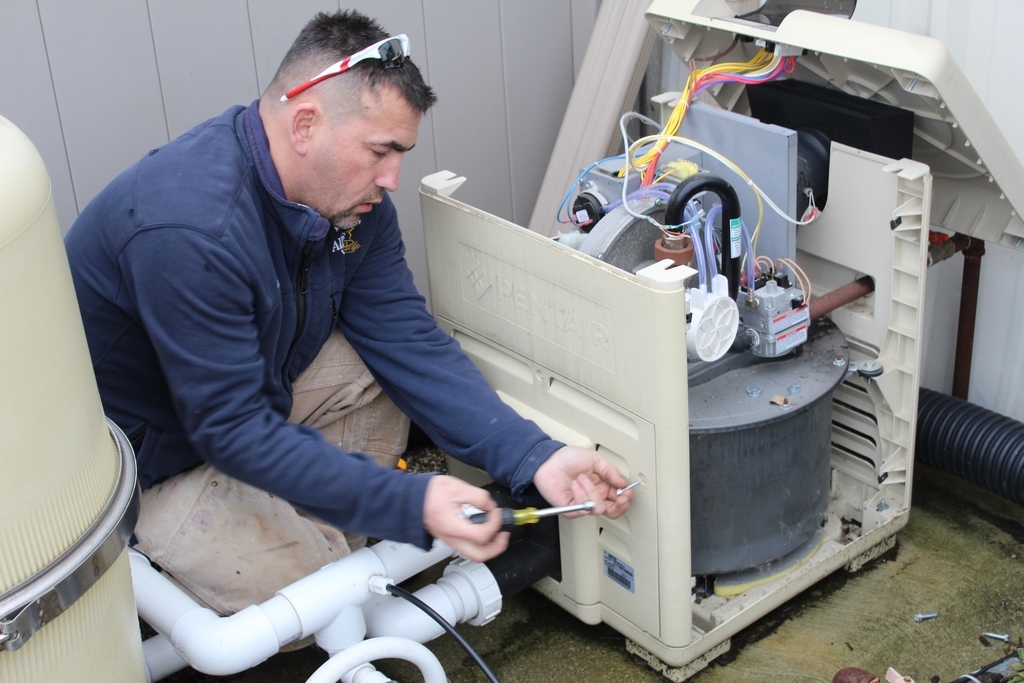
 The presence of unwanted cold water can lead to call-backs for builders and technicians who install heaters improperly. That’s not good, notes Mike Fowler, who writes that keeping customers warm and happy requires following these sizing, selection, installation and maintenance procedures.
The presence of unwanted cold water can lead to call-backs for builders and technicians who install heaters improperly. That’s not good, notes Mike Fowler, who writes that keeping customers warm and happy requires following these sizing, selection, installation and maintenance procedures.
When searching for the cause of pool-heater failure, many, if not most, are linked to improper installation, meaning it’s often the builder who has made an error of some kind. Installation missteps reveal themselves in a number of the most common heater malfunctions; but, can be reliably avoided with correct sizing and installation practices.
Watershaping professionals who want to be sure pool water stays warm throughout the year, should take the time to review the heater installation for each of the pools they install and/or maintain. This is especially true with pool heaters getting more use during the pandemic, as more and more people rely on their pools for recreation and exercise. Proper heater installation and maintenance also improves energy efficiency.
Here’s a handy review of heater-installation and service basics:
RIGHT SIZING
It is vital for the heater, along with other components in the equipment room, to be sized correctly for the facility’s pool, and additional bodies of water that might be connected such as spas, splash-play areas or even slides.
To size heating equipment properly, first compare the heater-specification to the anticipated flow rate. To calculate an approximate heater size for a pool, builders and service technicians should always follow these basic sizing steps:
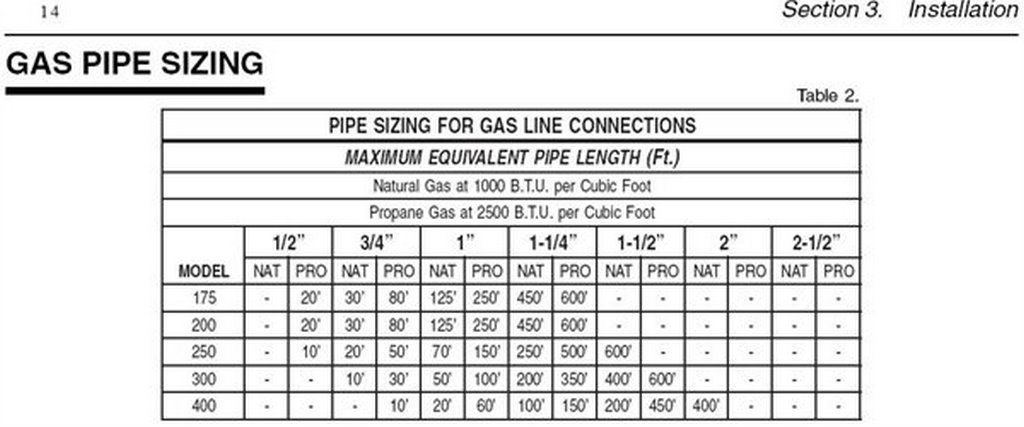 • Determine the desired pool water temperature (average is 82 F for competitive swimming).
• Determine the desired pool water temperature (average is 82 F for competitive swimming).
• Determine the average temperature for the coldest month the pool will be used (if it is an outdoor pool).
• Subtract the average ambient temperature for the coldest month from the desired pool water temperature. This will provide the temperature rise needed.
• Calculate the pool surface area in square feet.
• To determine the British thermal unit (Btu) output needed for gas pool heaters, you multiply the pool area (in square feet) by the temperature rise (ideal water temperature/average temperature in coldest month) by 12.
Keep in mind, heaters are sized based on a 24-hour temperature rise. Therefore, a heater with one million Btus takes 24 hours to raise the pool temperature 15 degrees for a 5,450 square foot pool.
Based on this information, you will be able to select the appropriate heater for the pool.
If the heater does not appear to be sized properly, it should probably be replaced. In fact, replacing older heaters with new, energy-efficient units will not only provide improved water heating but will also reduce energy consumption and lower operating costs.
RIGHT SUPPLY
It is also important for the gas meter to be sized appropriately for the heater. Assuming the pool heater is using natural gas, the meter must be sized, at a minimum, to the capacity of the heater itself. In other words, if you’re using a 400,000-Btu heater, the meter should be capable of providing 400,000 Btus. The same is true of the gas line itself, it has to be large enough to accommodate the required volume of fuel.
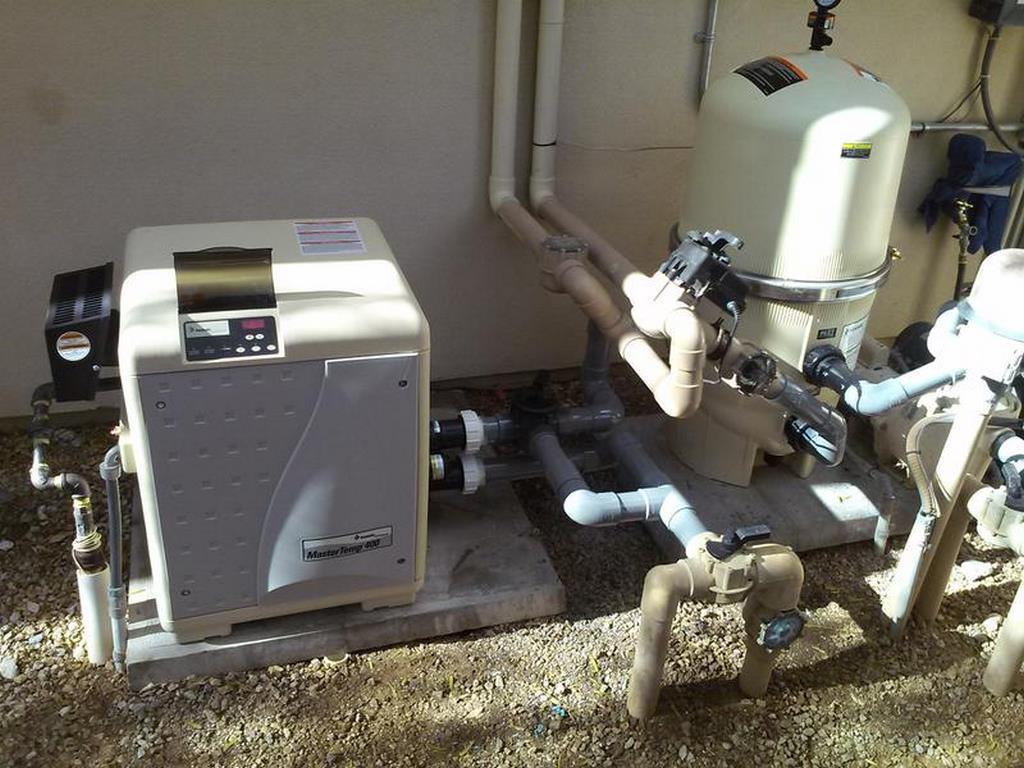 Always keep in mind that there may be other items pulling gas from that same meter, so those demands should also be factored into the meter sizing. Low gas pressure can cause damage to the internal components of a heater, causing build-up that leads to blockage of the heat exchanger.
Always keep in mind that there may be other items pulling gas from that same meter, so those demands should also be factored into the meter sizing. Low gas pressure can cause damage to the internal components of a heater, causing build-up that leads to blockage of the heat exchanger.
Here are some other supply-related sizing issues you should keep in mind:
• Propane tank: If the pool heater is propane-fueled, the tank must be large enough to supply the proper amount of gas to the heater. Improper gas pressures to the heater, while in operation, will decrease heater efficiencies and possibly cause soot build up, which could damage the burners, as well as the heat exchanger.
• Venting: Once again, sizing is very important. When venting heaters, it is important to maintain proper clearances of six inches from combustible surfaces on the top and side of the unit. Check the heater manufacturer’s manual for recommended clearances.
When considering how far a heater can be vented, or how far ductwork can run to pull intake air, remember that each 90-degree elbow reduces the maximum horizontal polyvinyl chloride (PVC) air intake run by 12 feet. Each 45-degree elbow reduces the maximum run by six feet.
• Air supply: The minimum requirements for air supply specify two permanent air supply openings in rooms where heaters are installed: one within 12-inches of the ceiling and the other within 12-inches of the floor for combustion air. This installation procedure is in accordance with the American National Standards Institute (ANSI) Z223.1, National Fuel Gas code, as applicable, and any local codes that may apply.
Air supply openings should connect to outdoor air, whether directly or through a duct. In the past, venting and air intake ducts had to be in balance and be the same length; however, with newer heaters, they draw combustible air from outside the structure and flue gases are forced out.
Note: The color of the heater’s flame is a good indicator of whether or not the unit is receiving enough combustible air to function properly. A clear, blue flame indicates the unit is burning 100% of the gas. If the flame is not getting enough air, it becomes orange and releases carbon that turns to soot and clogs heat exchangers.
One of the more common mistakes that occur when installing a new heater is upgrading the size of the unit without having a large enough gas supply. For example, if the pool previously had a gas line for a 200,000 Btu heater and the new unit is rated 400,000 Btus, the gas line also needs to be bigger to accommodate the increased output.
COMMON PROBLEMS
The symptoms associated with heater failure can generally be narrowed down to issues with a burner or the heat exchanger, which are commonly related to improper installation. Useful troubleshooting tips include:
• Loud, high-pitched whine: This symptom is generally associated with the burner; specifically with the flame being too “rich.” Check the pressure tap between the gas valve in the blower inlet and verify the gas regulator setting is -0.2 in. water column (wc). In some cases, it might be necessary to replace the gas orifice.
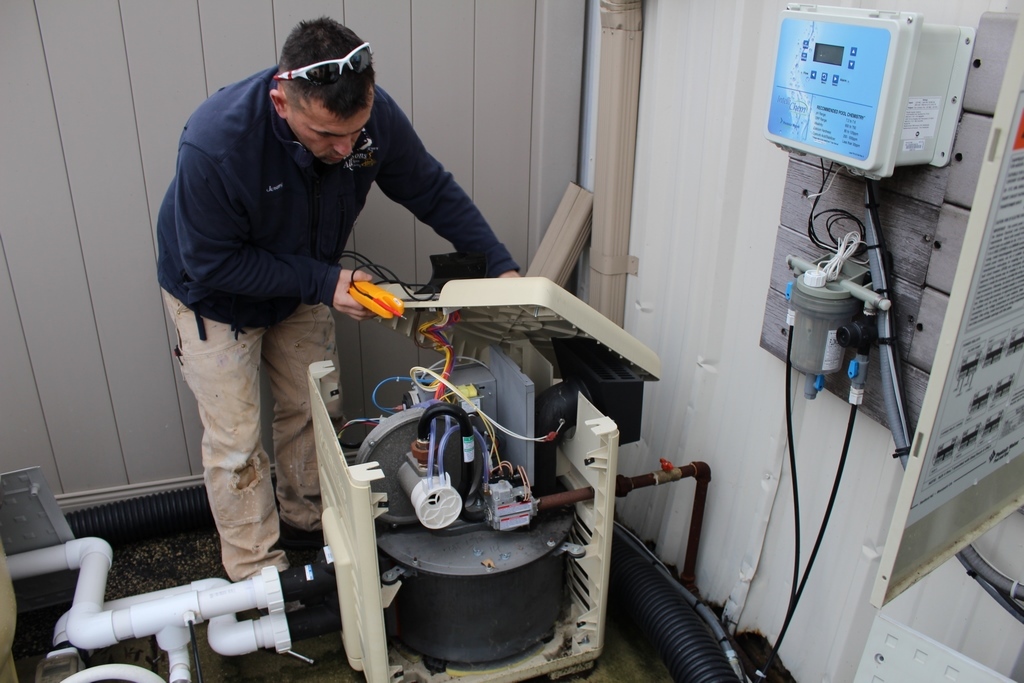 • Fluttering flames: Again, this is symptomatic of a burner issue and can be accompanied by an acrid smell from the exhaust. The cause is most likely the result of the flame being too ‘lean,’ and the burner may even fail to remain lit. As noted earlier, check the pressure tap between the gas valve in the blower inlet and verify the gas regulator setting is -0.2 wc inches.
• Fluttering flames: Again, this is symptomatic of a burner issue and can be accompanied by an acrid smell from the exhaust. The cause is most likely the result of the flame being too ‘lean,’ and the burner may even fail to remain lit. As noted earlier, check the pressure tap between the gas valve in the blower inlet and verify the gas regulator setting is -0.2 wc inches.
• Flame goes out: Sometimes the combustion on the heater appears to be normal, but the flame does not stay lit. This is most likely due to the flame not being detected. To remedy this situation, check the igniter to see if it is wet or possibly damaged. This may require the igniter to be replaced.
Further, verify that the burner flame holder is properly grounded. This might require the ignition control module to be replaced. Finally, be sure to inspect the manifold pressure. And, check the gas supply line pressure when the heater is operating.
• Boiling and “bumping” sounds: The heat exchanger can also cause several problems. One of the most common issues is the boiling of water accompanied by ‘bumping’ sounds. The caused is often low water flow to the heater. A plugged heat exchanger or a bypass valve that is stuck open can also be the cause.
The best way to fix this problem is to ensure the pump and filter are working properly, so the water flow is sufficient to the heater. If the heater is not getting good flow, first check to make sure your filter is clean. It may be due for a backwash or element cleaning. A dirty filter can reduce proper flow through the heater as well.
The heat exchanger could also be plugged by scale formation resulting from improper water chemistry. Test the water to identify corrective water-balance measures.
• Reduced water flow: When a pump is not working properly it can contribute to heater inefficiencies due to irregular water flow. If the water flow is too fast, it results in condensation. If it is too slow, the heater is not warming the water efficiently. If this is the problem, it might be a good time to consider a variable-frequency drive (VFD) to ensure consistent and optimum water flow.
• Condensation: Propane and natural gas, when burned, produce water as a byproduct. If the heat exchanger is too cool, the humid flue gases will condense on the fins of the heater. Condensation on the heat exchanger causes carbon to adhere to it. The condensate collects, then drops onto the burners. The combustion is then compromised by “raining” condensate distorting the flame pattern.
This poor combustion turns into ‘soot,’ which collects on the fins and impedes the flue gasses. The condensation not only compromises efficient heater function, but also causes copper oxidation from low return water temperatures.
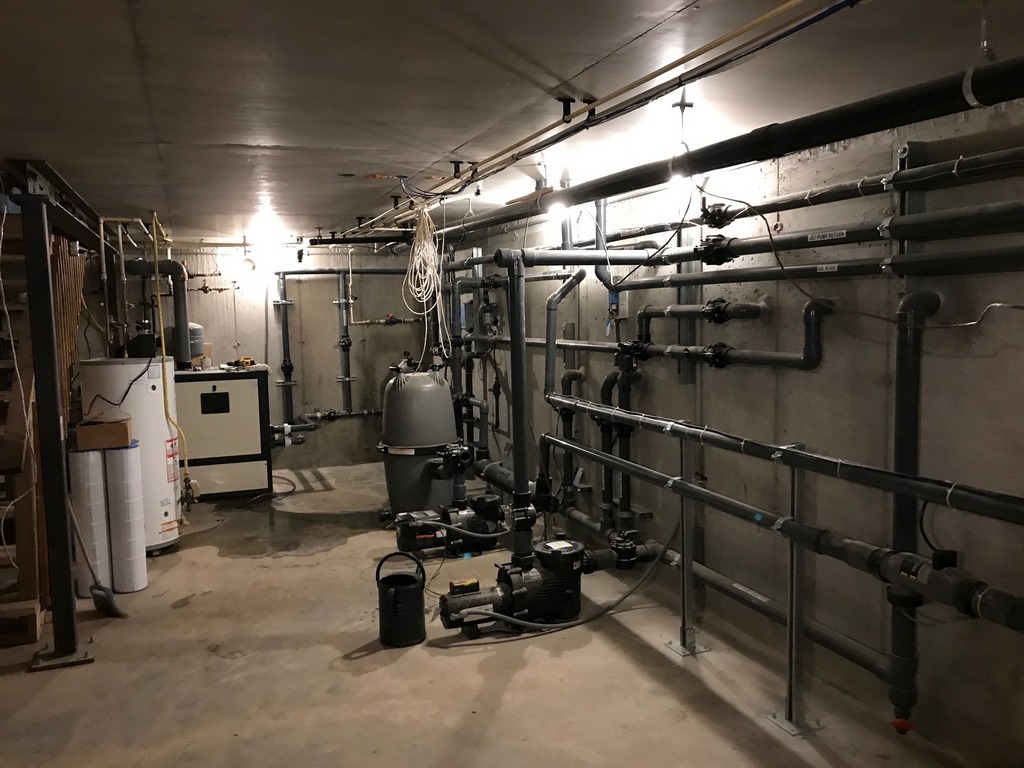 Brief periods of condensation on start-up is normal for most pool heaters. In fact, all category I and III pool water heaters will condense if allowed to send very low return water into the heat exchanger. However, adding airborne chemicals to condensate on heat exchanger coils will cause the unit to fail more quickly.
Brief periods of condensation on start-up is normal for most pool heaters. In fact, all category I and III pool water heaters will condense if allowed to send very low return water into the heat exchanger. However, adding airborne chemicals to condensate on heat exchanger coils will cause the unit to fail more quickly.
As mentioned earlier, and again below, ‘sooting’ is often the first sign of a problem, but is often ignored. In fact, some service technicians who have not been trained properly may place jumpers on safety devices instead of paying attention to the ‘sooting’ that occurs.
• Soot formation on heat exchanger tubes: There are several causes of soot formation on heat exchanger tubes. The first is low gas pressure. The heater needs an 11 in. wc for propane gas and a 4-in. wc for natural gas. The pressure of the gas should be inspected while the burners are lit.
Soot can also form when there is too much water flow through the heater. To remedy this, a high flow modulator or a manual bypass valve should be installed. Obstruction of the burners by some foreign matter can also be a problem; therefore, it is important to remove, inspect, and clean all burners.
COMMERICAL CONCERNS
All aquatic facilities should establish a comprehensive maintenance program for the equipment room, which must include a specific action plan for heaters, as well as the pumps and filtration systems.
It is also a good idea to keep additional parts on hand just in case an aquatic facility needs to get a heater up and running immediately. Having access to items such as pilot assemblies, orifice parts for burners, and even an extra gas valve is recommended. It is wise to post the phone number of a nearby service company directly on the heater for emergencies.
Avoiding heater problems this winter is important to all aquatic facility managers. Often times, the simplest best practices are the ones that keep pools running smoothly at all times.
Mike Fowler is the commercial sales manager for Pentair in Sanford, NC. He has been with the company since 1992, starting his career in the technical services department at Purex Pool Products. He can be reached via e-mail at [email protected].









